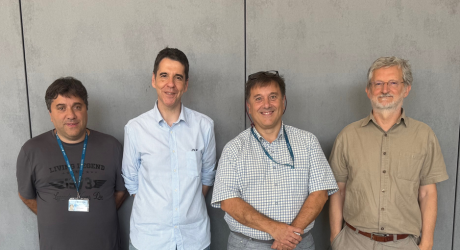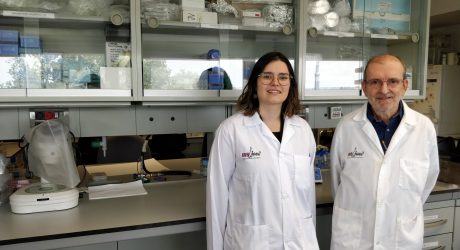A researcher from the IISPV and the URV is coordinating an international project that will improve the detection and prevention of breast cancer
- The project will make possible the classification of the different types of breast cancer and predict the probability of metastasis thanks to the joint analysis of radiological and microscopic images.
- It will be led by researcher Domènec Puig from the Institut d’Investigació Sanitària Pere Virgili (IISPV) and Universitat Rovira i Virgili (URV: ITAKA research group).
Researcher Domènec Puig from the IISPV and the URV will coordinate an international project that must play a key role in the detection and prevention of breast cancer. This is the BosomShield project, aimed at the development of a software platform that analyzes images to classify the different types of breast cancer and to predict their dangerousness and the probability of relapse due to metastasis.
The project is led by the Robotics and Intelligent Vision laboratory of the URV, headed by researcher Domènec Puig, of the IISPV and part of the ITAKA research group of the Department of Computer Engineering and Mathematics (DEIM) of the university. It has the collaboration of universities, hospitals, biomedical research groups and European, Asian and North American technology centers. It is financed by the Marie-Sklodowska Curie Actions (Horizon MSCA), the reference program of the European Union for doctoral and postdoctoral training. It will last until 2026.
“The main novelty of the project is that for the first time are put together the analysis of radiological images, that is to say, mammograms, magnetic resonances…, and the analysis of histopathological images, the microscopic images of the cells. These two types of images have until now been analyzed separately, and the fact of working together allows a much more accurate prediction, to advance to the maximum, to specify their characteristics, benignity or malignancy, and the possibilities of metastasis, expansion beyond the chest, recurrence…”, explains Domènec Puig.
The project is divided into ten subprojects, each developed by one of the partners and dealing with the different phases of the process: the analysis of the radiological images, the analysis of the histopathological images, the prediction of the possibility of relapse combining the two types of images and the design of the platform. Those responsible for each subproject are PhD candidates chosen by each institution. “According to European mobility rules, candidates must have resided in the country of which each institution is a part for a maximum of one year out of the last three, which encourages a very interesting international exchange”, points out Puig.
The URV team is in charge of the first sub-project, which aims to “determine the molecular subtype of breast cancer using multimodal radiological images”, as explained by Hatem Rashwan, researcher at the Robotics and Intelligent Vision laboratory and DEIM visiting professor: “It is not a simple task, but thanks to deep learning and artificial intelligence we can find the tumor markers through these radiological images.” Rashwan emphasizes the fact of determining the molecular subtypes of cancer, since “it allows us to know if it is dangerous or if there may be a relapse after a few years, in this case in collaboration with the Swedish partners”. In this sense, Domènec Puig explains that the sub-projects are designed to be interrelated, with meetings and common posts and a lot of mobility, with stays of those responsible for each project in the other institutions.
The role of the IISPV
The Oncological Pathology and Bioinformatics Research Group of the Institut d’Investigació Sanitària Pere Virgili (IISPV) participates in this project focusing on the analysis of the role of the immune response of the axillary lymph nodes with the risk of relapse due to distant metastasis. In this regard, Carlos López (who together with Marylene Lejeune are responsible for the group) emphasizes that it is essential to study a patient’s risk factors for developing this type of metastasis since when this occurs it is very likely that it will not survive. The Hospital Universitari Sant Joan (Reus) and the Hospital Verge de la Cinta (Tortosa, where this research group is located), are also involved in the project.
“Our body’s immune response is the defenses that protect us from both viruses and bacteria, but which have also been seen to play an important role in the evolution of tumors. In breast cancer, the immune response to the primary breast tumor has been investigated, but there are very few studies focused on its study in the axillary lymph node, which is usually the first place where breast cancer it metastasizes regionally. Our role in the project is to provide the clinical, pathological and radiological digital images and also at the histological level of the patients’ biopsies to be able to integrate all the information to identify those patients with a greater risk of distant metastasis. The most innovative part of the project apart from the application of artificial intelligence is the integration of information from the immune response of the lymph nodes”, explains Carlos López.
“In the end, together, we will create a platform within the scope of clinical practice, which will be in hospitals, which will allow the specialist doctor to receive a warning from the system, for example if there is any suspicion in a particular patient, and that it helps you make better, more grounded and efficient decisions”, says Domènec Puig, whose team has been working on projects to help diagnose breast cancer for some time. In fact, the idea of the project arises from the URV, side by side with the IISPV, giving it shape until finding the most refined proposal and contacting the rest of the institutions until forming the consortium that will take it forward. “This is our big project, the one that encompasses everything we’ve done so far and the one that will lead to having a universal, functional and adequate system”, concludes Puig.




